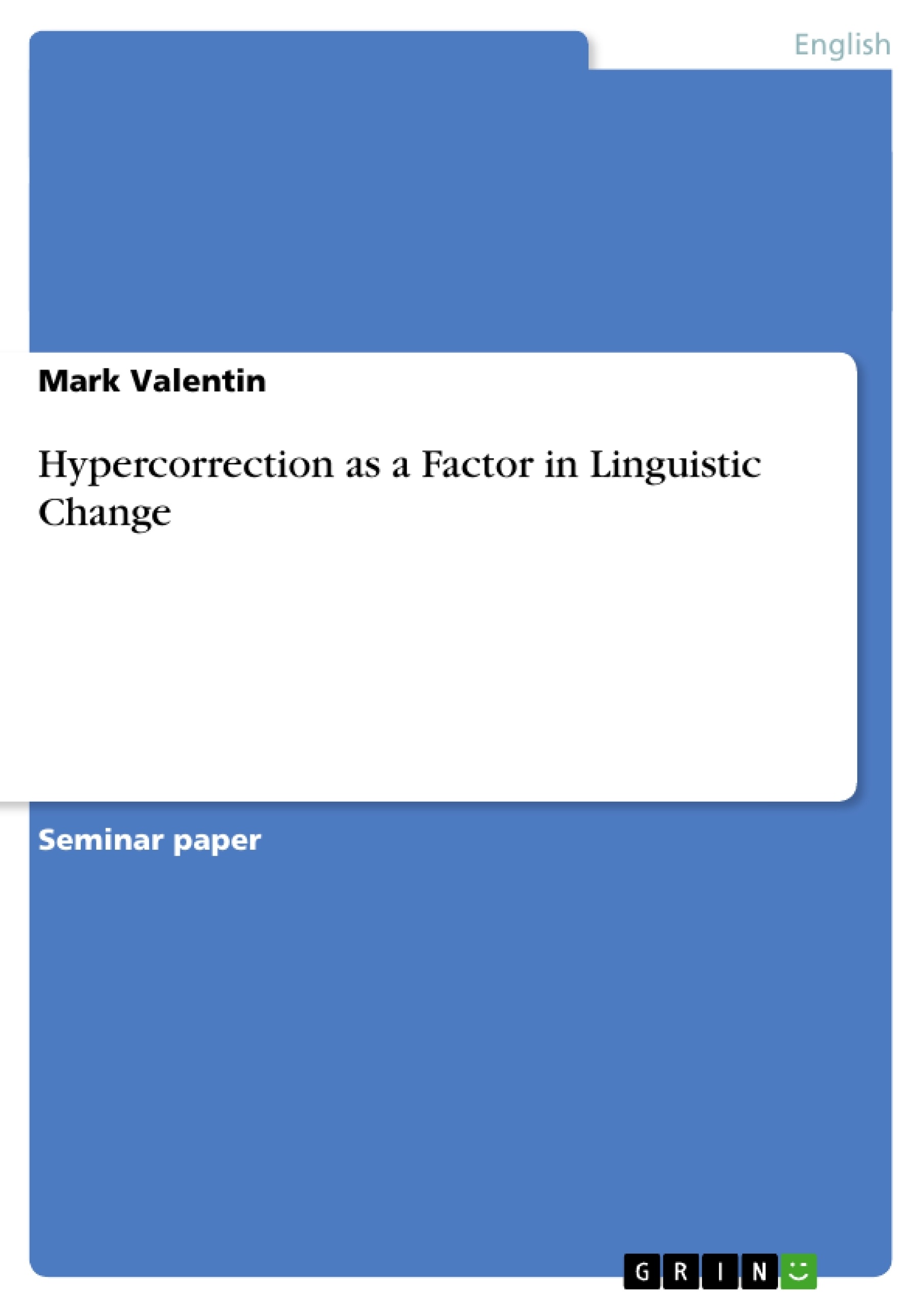Hypercorrection is a term of high significance in sociolinguistics. This article aims to clarify what exactly is meant by this widely discussed phenomenon. In this context, it is not only important to explain what is meant by the term itself, but also to describe hypercorrection as a factor in linguistic change. Very fruitful and extensive research on this topic has been carried out by William Labov, who examined “Hypercorrection by the Lower Middle Class as a Factor in Linguistic Change” (Labov [a]). It is Labov, who shows that there is another factor, which is of high significance when it comes to hypercorrection and which consequently needs to be further clarified in this context: social status.
Table of Contents
- I. Introduction
- II. Hypercorrection as a Factor in Linguistic Change
Objectives and Key Themes
This article aims to clarify the meaning of hypercorrection and its role in linguistic change, focusing on William Labov's research. It explores the definition of hypercorrection, its manifestation in prestige markers across different social groups, and the influence of social status on its occurrence.
- Definition and Misinterpretations of Hypercorrection
- Hypercorrection as a Function of Rule Generalization
- Social Status and Hypercorrection
- Labov's Approach and Methodology
- The Role of Prestige Markers (e.g., /r/ pronunciation)
Chapter Summaries
I. Introduction: This introductory chapter establishes hypercorrection as a significant concept in sociolinguistics. It highlights the need to clarify the term's meaning and its function as a factor in linguistic change, emphasizing the importance of William Labov's research on the topic, particularly his focus on the influence of social status. The introduction lays the groundwork for the subsequent discussion by identifying the central research question and indicating the key areas to be explored in the article.
II. Hypercorrection as a Factor in Linguistic Change: This chapter delves into the complexities of defining hypercorrection, acknowledging the inherent ambiguity and potential for misinterpretations. It presents various perspectives on the definition, contrasting purely linguistic views with sociolinguistic ones. The chapter highlights the role of rule generalization and the connection between hypercorrection and the adoption of prestige markers by different social groups. Labov's approach, which links hypercorrection to social status, is presented as a crucial framework for understanding the phenomenon. The chapter emphasizes the study of the lower middle class and their dynamic speech behavior as a primary focus, along with a brief overview of Labov's methodology, which includes quantitative measurement of phonological indexes and the observation of linguistic forms as prestige markers. The significance of the pronunciation of /r/ as a prestige marker, its historical development, and its role in sociolinguistic variation across different social groups and speech styles are also highlighted. The chapter concludes by setting the stage for a detailed analysis of Labov's findings on the correlation between social class and hypercorrection, focusing on the specific behaviors of the lower middle class in New York City.
Keywords
Hypercorrection, linguistic change, sociolinguistics, social status, prestige markers, rule generalization, William Labov, lower middle class, /r/ pronunciation, quantitative analysis, speech style.
Frequently Asked Questions: A Comprehensive Language Preview
What is the main topic of this language preview?
This preview focuses on hypercorrection as a significant concept in sociolinguistics, particularly its role in linguistic change and its connection to social status. It heavily emphasizes the research and methodology of William Labov.
What are the key themes explored in this preview?
The key themes include the definition and potential misinterpretations of hypercorrection; hypercorrection as a function of rule generalization; the influence of social status on hypercorrection; Labov's approach and methodology; and the role of prestige markers, specifically the pronunciation of /r/, in sociolinguistic variation.
What is hypercorrection, and why is it important?
Hypercorrection refers to the phenomenon where speakers overcorrect their speech, often in an attempt to sound more prestigious or educated. It's important because it reveals insights into how language changes over time and how social factors influence language use.
How does social status relate to hypercorrection?
The preview highlights the strong correlation between social status and hypercorrection. It examines how different social groups, particularly the lower middle class, exhibit hypercorrection in their speech, often in relation to prestige markers.
What is Labov's contribution to the understanding of hypercorrection?
William Labov's research is central to this preview. His work, focusing on quantitative analysis of phonological indexes and the observation of linguistic forms as prestige markers, provides a crucial framework for understanding the complexities of hypercorrection and its connection to social class.
What specific methodology does Labov use?
Labov's methodology involves quantitative measurement of phonological indexes and the observation of linguistic forms as prestige markers. His research often focuses on specific linguistic features, such as the pronunciation of /r/, to analyze sociolinguistic variation across different social groups and speech styles.
What is the role of prestige markers in hypercorrection?
Prestige markers, such as the pronunciation of /r/, serve as key indicators in the study of hypercorrection. Speakers attempt to adopt these markers to align with higher social classes, sometimes leading to overcorrection.
What is the focus of the chapter on "Hypercorrection as a Factor in Linguistic Change"?
This chapter delves into the complexities of defining hypercorrection, explores different perspectives on its definition, highlights the role of rule generalization, and details Labov's approach to understanding this phenomenon, particularly focusing on the speech patterns of the lower middle class in New York City and the significance of /r/ pronunciation.
What are the key chapters covered in this preview?
The preview covers an introduction establishing hypercorrection as a significant sociolinguistic concept and a chapter focusing on hypercorrection as a factor in linguistic change, emphasizing Labov's research and methodology.
What are the keywords associated with this topic?
Key terms include: Hypercorrection, linguistic change, sociolinguistics, social status, prestige markers, rule generalization, William Labov, lower middle class, /r/ pronunciation, quantitative analysis, speech style.
- Quote paper
- B.A. Mark Valentin (Author), 2010, Hypercorrection as a Factor in Linguistic Change, Munich, GRIN Verlag, https://www.grin.com/document/167980




